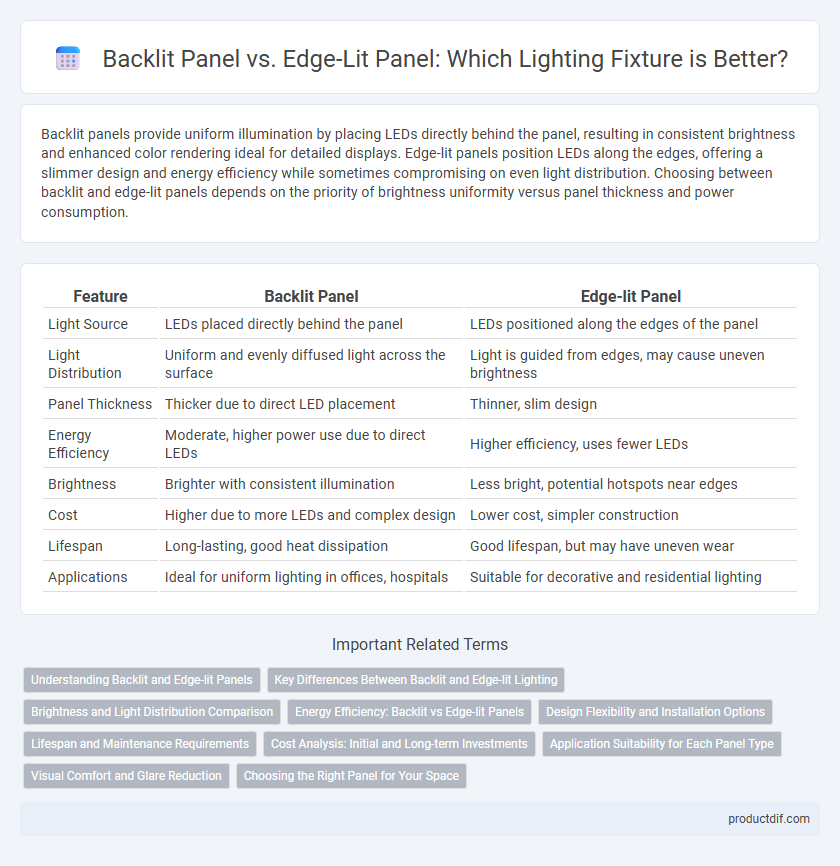Backlit panels provide uniform illumination by placing LEDs directly behind the panel, resulting in consistent brightness and enhanced color rendering ideal for detailed displays. Edge-lit panels position LEDs along the edges, offering a slimmer design and energy efficiency while sometimes compromising on even light distribution. Choosing between backlit and edge-lit panels depends on the priority of brightness uniformity versus panel thickness and power consumption.
Table of Comparison
| Feature | Backlit Panel | Edge-lit Panel |
|---|---|---|
| Light Source | LEDs placed directly behind the panel | LEDs positioned along the edges of the panel |
| Light Distribution | Uniform and evenly diffused light across the surface | Light is guided from edges, may cause uneven brightness |
| Panel Thickness | Thicker due to direct LED placement | Thinner, slim design |
| Energy Efficiency | Moderate, higher power use due to direct LEDs | Higher efficiency, uses fewer LEDs |
| Brightness | Brighter with consistent illumination | Less bright, potential hotspots near edges |
| Cost | Higher due to more LEDs and complex design | Lower cost, simpler construction |
| Lifespan | Long-lasting, good heat dissipation | Good lifespan, but may have uneven wear |
| Applications | Ideal for uniform lighting in offices, hospitals | Suitable for decorative and residential lighting |
Understanding Backlit and Edge-lit Panels
Backlit panels feature LEDs distributed evenly behind the entire surface, providing uniform illumination with minimal shadows and greater brightness. Edge-lit panels position LEDs along the edges, using a light guide to disperse light across the panel, resulting in a thinner design but potential brightness variation. Understanding these differences helps in selecting the right lighting fixture for applications requiring consistent light quality or sleek aesthetics.
Key Differences Between Backlit and Edge-lit Lighting
Backlit panels feature LEDs distributed evenly behind the entire surface, offering uniform brightness and consistent light diffusion ideal for high-contrast displays. Edge-lit panels place LEDs along the edges, utilizing light guides to spread illumination, resulting in thinner fixtures with slightly less uniform brightness. The primary difference lies in light distribution and thickness, with backlit panels delivering superior uniformity and edge-lit panels prioritizing slim design and energy efficiency.
Brightness and Light Distribution Comparison
Backlit panels provide uniform brightness and even light distribution by placing LEDs directly behind the panel, resulting in higher luminosity and minimal hot spots. Edge-lit panels feature LEDs positioned along the edges, causing light to diffuse through a light guide, which often creates less uniform brightness and potential variations in light intensity. For applications requiring consistent illumination and superior brightness, backlit panels generally outperform edge-lit alternatives.
Energy Efficiency: Backlit vs Edge-lit Panels
Backlit panels utilize LEDs distributed across the entire back surface, resulting in more uniform light distribution and higher energy efficiency compared to edge-lit panels, which place LEDs only along the edges. Due to reduced light loss and better heat dissipation, backlit panels often consume less power while providing brighter illumination. Edge-lit panels, although thinner, may require higher wattage to achieve comparable brightness, leading to increased energy consumption.
Design Flexibility and Installation Options
Backlit panels offer greater design flexibility by providing uniform illumination across the entire surface, making them ideal for high-contrast graphics and vibrant displays. Edge-lit panels are thinner and lighter, enabling easier installation in tight spaces and seamless integration into ceilings and walls. Both options accommodate various mounting methods, but backlit panels often require deeper fixtures due to the rear light source, while edge-lit panels support slimmer, recessed installations.
Lifespan and Maintenance Requirements
Backlit panels typically offer a longer lifespan compared to edge-lit panels due to their use of direct LED placement, which reduces heat buildup and prolongs LED efficiency. Maintenance requirements for backlit panels are generally lower as their design minimizes dust accumulation and simplifies cleaning. Edge-lit panels may require more frequent maintenance to address potential light diffusion issues and LED wear over time.
Cost Analysis: Initial and Long-term Investments
Backlit panels typically require higher initial investment due to integrated LED arrays behind the diffuser, resulting in more complex manufacturing and assembly costs. Edge-lit panels generally offer lower upfront expenses since LEDs are placed only along the edges, but may incur higher long-term maintenance due to less uniform light distribution and potential lifespan reduction. Evaluating total cost of ownership reveals that backlit panels, although pricier initially, often provide longer durability and energy efficiency, leading to lower operational costs over time.
Application Suitability for Each Panel Type
Backlit panels provide uniform illumination, making them ideal for high-accuracy tasks such as graphic design and medical imaging where consistent brightness is crucial. Edge-lit panels excel in energy efficiency and slim designs, suitable for residential spaces and architectural lighting where aesthetics and space-saving are priorities. Choosing the right panel depends on application demands like light uniformity, energy consumption, and installation constraints.
Visual Comfort and Glare Reduction
Backlit panels provide uniform light distribution across the entire surface, significantly enhancing visual comfort by minimizing hotspots and glare, making them ideal for environments requiring prolonged screen exposure. Edge-lit panels, while slimmer and more energy-efficient, often produce uneven light dispersion that can increase glare and visual discomfort, especially in workspaces with high ambient light. Choosing backlit technology promotes superior glare reduction and consistent illumination, crucial for optimizing eye comfort and reducing strain.
Choosing the Right Panel for Your Space
Backlit panels provide uniform illumination by placing LEDs directly behind the panel, resulting in brighter and more consistent light distribution ideal for larger or dimly lit spaces. Edge-lit panels position LEDs around the panel's edges, offering a slimmer profile and energy efficiency, making them suitable for residential or office environments where aesthetics and lower power consumption are priorities. Selecting the right panel depends on balancing brightness requirements, installation space, and energy efficiency to optimize lighting performance and ambiance.
Backlit panel vs Edge-lit panel Infographic

 productdif.com
productdif.com